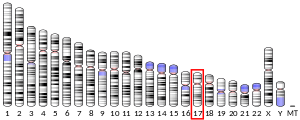OR1E2
Olfactory receptor 1E2 is a protein that in humans is encoded by the OR1E2 gene.[4][5][6]
Olfactory receptors interact with odorant molecules in the nose, to initiate a neuronal response that triggers the perception of a smell. The olfactory receptor proteins are members of a large family of G-protein-coupled receptors (GPCR) arising from single coding-exon genes. Olfactory receptors share a 7-transmembrane domain structure with many neurotransmitter and hormone receptors and are responsible for the recognition and G protein-mediated transduction of odorant signals. The olfactory receptor gene family is the largest in the genome. The nomenclature assigned to the olfactory receptor genes and proteins for this organism is independent of other organisms.[6]
See also
References
- GRCh38: Ensembl release 89: ENSG00000127780 - Ensembl, May 2017
- "Human PubMed Reference:". National Center for Biotechnology Information, U.S. National Library of Medicine.
- "Mouse PubMed Reference:". National Center for Biotechnology Information, U.S. National Library of Medicine.
- Ben-Arie N, Lancet D, Taylor C, Khen M, Walker N, Ledbetter DH, Carrozzo R, Patel K, Sheer D, Lehrach H, et al. (Jul 1994). "Olfactory receptor gene cluster on human chromosome 17: possible duplication of an ancestral receptor repertoire". Hum Mol Genet. 3 (2): 229–35. doi:10.1093/hmg/3.2.229. PMID 8004088.
- Rouquier S, Taviaux S, Trask BJ, Brand-Arpon V, van den Engh G, Demaille J, Giorgi D (Mar 1998). "Distribution of olfactory receptor genes in the human genome". Nat Genet. 18 (3): 243–50. doi:10.1038/ng0398-243. PMID 9500546.
- "Entrez Gene: OR1E2 olfactory receptor, family 1, subfamily E, member 2".
Further reading
- Gotschlich EC (1975). "Development of polysaccharide vaccines for the prevention of meningococcal diseases". Monographs in Allergy. 9: 245–58. PMID 804088.
- Gerhard DS, Wagner L, Feingold EA, et al. (2004). "The status, quality, and expansion of the NIH full-length cDNA project: the Mammalian Gene Collection (MGC)". Genome Res. 14 (10B): 2121–7. doi:10.1101/gr.2596504. PMC 528928. PMID 15489334.
- Malnic B, Godfrey PA, Buck LB (2004). "The human olfactory receptor gene family". Proc. Natl. Acad. Sci. U.S.A. 101 (8): 2584–9. doi:10.1073/pnas.0307882100. PMC 356993. PMID 14983052.
- Strausberg RL, Feingold EA, Grouse LH, et al. (2003). "Generation and initial analysis of more than 15,000 full-length human and mouse cDNA sequences". Proc. Natl. Acad. Sci. U.S.A. 99 (26): 16899–903. doi:10.1073/pnas.242603899. PMC 139241. PMID 12477932.
- Fuchs T, Malecova B, Linhart C, et al. (2003). "DEFOG: a practical scheme for deciphering families of genes". Genomics. 80 (3): 295–302. doi:10.1006/geno.2002.6830. PMID 12213199.
- Glusman G, Sosinsky A, Ben-Asher E, et al. (2000). "Sequence, structure, and evolution of a complete human olfactory receptor gene cluster". Genomics. 63 (2): 227–45. doi:10.1006/geno.1999.6030. PMID 10673334.
External links
- OR1E2+protein,+human at the US National Library of Medicine Medical Subject Headings (MeSH)
This article incorporates text from the United States National Library of Medicine, which is in the public domain.

